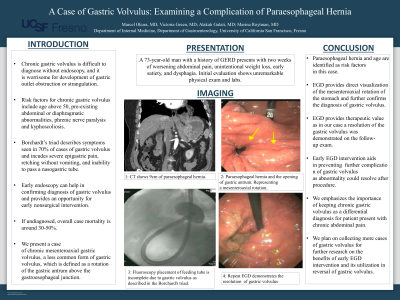Back


Poster Session C - Monday Afternoon
Category: General Endoscopy
C0304 - A Case of Gastric Volvulus: Examining a Complication of Paraesophageal Hernia
Monday, October 24, 2022
3:00 PM – 5:00 PM ET
Location: Crown Ballroom

Has Audio

Marcel Okura, MD
UCSF Fresno
Fresno, CA
Presenting Author(s)
Marcel Okura, MD, VIctoria Green, MD, Alakh Gulati, MD, Marina Roytman, MD
UCSF Fresno, Fresno, CA
Introduction: Gastric volvulus (GV) is defined as rotation of the stomach beyond 180 degrees. This rotation can further leads to gastric outlet obstruction or strangulation. Without prompt intervention GV can progress to necrosis or stomach perforation. Overall case mortality of GV ranges from 30-50%. Risk factors associated with GV are age above 50, diaphragmatic abnormalities, phrenic nerve paralysis, kyphoscoliosis, and other abdominal anatomic abnormalities. Symptoms of acute GV as described in Borchardt’s triad often include severe epigastric pain, retching without vomiting and inability to pass a nasogastric tube. Borchardt’s triad is seen in 70% of reported acute GV. Chronic GV can present with Borchard's triad but often more subtle and nonspecific symptoms, which makes diagnosis difficult. GV further classifies into organoaxial rotation and mesenteroaxial rotation. Mesenteroaxial rotation describes rotation of the antrum of the stomach above the gastroesophageal (GE) junction and is a less commonly seen form of GV. Esophagogastroduodenoscopy (EGD) offers an opportunity for nonsurgical intervention or temporary relief while confirming the anatomic rotations that are often not visualized on computer tomography (CT).
Case Description/Methods: A 73-year-old man with a history of gastroesophageal reflux disease (GERD) presented with two weeks of worsening abdominal pain, unintentional weight loss, early satiety, and dysphagia. Patient reported low intensity intermittent sharp abdominal pain in the epigastric region. He associated the pain with food intake and dysphagia with solids. He endorsed nausea but denied vomiting or hematemesis. He has no other significant medical history. His arrival vital signs and labs were all within normal range. CT angiogram of the abdomen revealed a left sided paraesophageal hernia. A subsequent EGD with attempted decompression was performed. Results showed opening of the antrum within the large paraesophageal hernia confirming mesenteroaxial GV. Subsequent day EGD confirmed the resolution of GV after detorsion attempt. Patient underwent surgical paraesophageal hernia repair prior to discharge. He returned to his usual state of health on a recent follow up visit.
Discussion: GV should be considered as a differential diagnosis for nonspecific abdominal pain. Complete resolution of GV may be achieved after prompt and early EGD. This case highlights that early EGD may prevent progression of acute complications and potentially decrease mortality.

Disclosures:
Marcel Okura, MD, VIctoria Green, MD, Alakh Gulati, MD, Marina Roytman, MD. C0304 - A Case of Gastric Volvulus: Examining a Complication of Paraesophageal Hernia, ACG 2022 Annual Scientific Meeting Abstracts. Charlotte, NC: American College of Gastroenterology.
UCSF Fresno, Fresno, CA
Introduction: Gastric volvulus (GV) is defined as rotation of the stomach beyond 180 degrees. This rotation can further leads to gastric outlet obstruction or strangulation. Without prompt intervention GV can progress to necrosis or stomach perforation. Overall case mortality of GV ranges from 30-50%. Risk factors associated with GV are age above 50, diaphragmatic abnormalities, phrenic nerve paralysis, kyphoscoliosis, and other abdominal anatomic abnormalities. Symptoms of acute GV as described in Borchardt’s triad often include severe epigastric pain, retching without vomiting and inability to pass a nasogastric tube. Borchardt’s triad is seen in 70% of reported acute GV. Chronic GV can present with Borchard's triad but often more subtle and nonspecific symptoms, which makes diagnosis difficult. GV further classifies into organoaxial rotation and mesenteroaxial rotation. Mesenteroaxial rotation describes rotation of the antrum of the stomach above the gastroesophageal (GE) junction and is a less commonly seen form of GV. Esophagogastroduodenoscopy (EGD) offers an opportunity for nonsurgical intervention or temporary relief while confirming the anatomic rotations that are often not visualized on computer tomography (CT).
Case Description/Methods: A 73-year-old man with a history of gastroesophageal reflux disease (GERD) presented with two weeks of worsening abdominal pain, unintentional weight loss, early satiety, and dysphagia. Patient reported low intensity intermittent sharp abdominal pain in the epigastric region. He associated the pain with food intake and dysphagia with solids. He endorsed nausea but denied vomiting or hematemesis. He has no other significant medical history. His arrival vital signs and labs were all within normal range. CT angiogram of the abdomen revealed a left sided paraesophageal hernia. A subsequent EGD with attempted decompression was performed. Results showed opening of the antrum within the large paraesophageal hernia confirming mesenteroaxial GV. Subsequent day EGD confirmed the resolution of GV after detorsion attempt. Patient underwent surgical paraesophageal hernia repair prior to discharge. He returned to his usual state of health on a recent follow up visit.
Discussion: GV should be considered as a differential diagnosis for nonspecific abdominal pain. Complete resolution of GV may be achieved after prompt and early EGD. This case highlights that early EGD may prevent progression of acute complications and potentially decrease mortality.

Figure: Gastric volvulus on CT, EGD, and resolution.
Disclosures:
Marcel Okura indicated no relevant financial relationships.
VIctoria Green indicated no relevant financial relationships.
Alakh Gulati indicated no relevant financial relationships.
Marina Roytman indicated no relevant financial relationships.
Marcel Okura, MD, VIctoria Green, MD, Alakh Gulati, MD, Marina Roytman, MD. C0304 - A Case of Gastric Volvulus: Examining a Complication of Paraesophageal Hernia, ACG 2022 Annual Scientific Meeting Abstracts. Charlotte, NC: American College of Gastroenterology.
